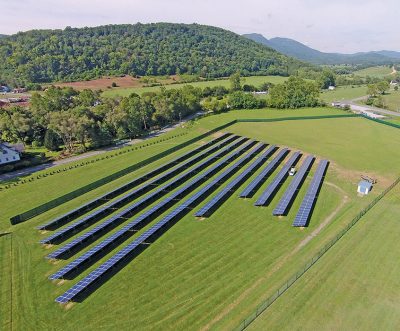Front Porch Blog

BARC’s solar farm contains 1,750 solar panels and produces 550 kilowatts of energy. Photo courtesy of the BARC Electric Cooperative
Editor’s note: Versions of this story first appeared in the December-January issue of The Appalachian Voice and the December 15 edition of the Mountain Times.
“We’re at an age where we need to start looking at alternative energy,” says Olivia Haney, an electric cooperative member in Virginia since 1989.
Many electric co-ops in the Southeast agree. Blue Ridge Electric Membership Corporation in North Carolina, BARC Electric Cooperative in Virginia and the Appalachian Electric Cooperative in Tennessee have each recently launched community solar projects to help members save money while reducing carbon emissions.
Community solar is a cooperative alternative to installing solar panels on an individual residence. Instead of dealing with the upfront and maintenance costs of solar panel installation on their house, homeowners can invest in a solar farm, or array of solar panels, provided by the electric cooperative. Community solar also allows co-op members with homes not suitable for solar panel installation due to the shading and positioning of the building to benefit from renewable energy.
Blue Ridge Electric Membership Corporation recently completed construction of four solar farms located in Watauga, Ashe, Alleghany and Caldwell counties in North Carolina. Each of the solar arrays contains 368 solar panels. Together, the four arrays can produce over 600,000 kilowatt hours of electricity per year.
Co-op members can subscribe to the energy produced by individual solar panels, up to a maximum of 10 panels, for a monthly fee of $4.50 per panel. The energy produced by their share of the solar array will show up as a credit on their electricity bill.
The solar panels went into operation on November 23. Within the first three weeks, 111 members subscribed to a total of over 300 panels.
“A lot of the interest has been driven by a financial interest so far,” says Jon Jacob, Energy Solutions Marketing Manager for Blue Ridge Electric. However, based on the utility’s model, cost savings will only be possible for members who use high amounts of energy. According to Jacob, Blue Ridge Electric is also reaching out to members interested in the environmental benefits of solar energy.
Blue Ridge Electric serves over 70,000 members, providing electricity to the majority of Watauga, Ashe, Alleghany and Caldwell counties, as well as portions of Avery, Wilkes and Alexander counties. Residential and small commercial customers are eligible to participate in the program.
The View from Virginia and Tennessee
BARC Electric Cooperative’s solar farm consists of 1,750 solar panels. The new project provides up to one-fourth of the total energy needs of each of the 220 households that have joined the solar program.
Community members who live in the five rural counties in Virginia that BARC covers can apply to be a part of the program. This co-op covers all of Bath County and parts of Highland, Alleghany, Augusta and Rockbridge counties. BARC member Haney joined the community solar program after learning about the environmental benefits of renewable energy.
Appalachian Electric Cooperative, based in New Market, Tenn., has also recently started a community solar program. According to Mitch Cain, the co-op’s director of member services, the solar array — which consists of 9,471 panels at 145 watts each — is in a test phase and will be fully operational on Jan. 12. Any residential or commercial member of Appalachian Electric can take part in this new initiative.
Subscribers to Appalachian Electric’s solar program can invest in individual solar panels. Members pay $125 per 145-watt panel as an upfront cost. There is a cap at 5,000 watts per residential customer and 10,000 watts for commercial subscriptions. Members begin receiving solar energy credits on their bills the month after they start the program. The time needed to recover a member’s investment is estimated to be about 12 years.
Community Solar’s Effect on Carbon Emissions
Solar panels convert energy from the sun into electricity that can be used in place of other non-renewable sources such as coal and natural gas, which emit carbon dioxide and contribute to climate change.
According to Blue Ridge Electric, each solar array has offset between three to four tons of carbon dioxide in the first couple weeks of operation. Together, the arrays could offset as much as 375 tons of carbon dioxide per year.
BARC’s calculations state that their solar project will prevent 11,000 metric tons of carbon dioxide from being released into the atmosphere.
Appalachian Electric’s program projects that 202 pounds of carbon will be offset per year for each panel installed. Over 20 years, one panel will keep 3,866 pounds of carbon from entering the atmosphere.
“Solar is here. It is something we can harness and use to help us and help the environment,” BARC co-op member Olivia Haney says. “Hopefully we will see more of this, and hopefully we will see more than just the co-ops looking to do this.”
Blue Ridge Electric members interested in the community solar program can visit blueridgeemc.com/solar or contact Jon Jacob, Energy Solutions Marketing Manager, at 828-759-8956 or jjacob@bluerigeemc.com.
BARC Electric Cooperative members interested in the community solar program can visit barcelectric.com/communitySolar or call (800) 846-2272.
Appalachian Electric Cooperative members interested in the solar program can visit aecoop.org/co-op-community-solar or call 865-475-2032 ext. 1880.
The Appalachian Voice Editorial Assistant Tristin Van Ord contributed to this story. To read her original piece in The Appalachian Voice, click here.
PREVIOUS
NEXT

Leave a comment
Your email address will not be published. Required fields are marked *

Leave a Comment